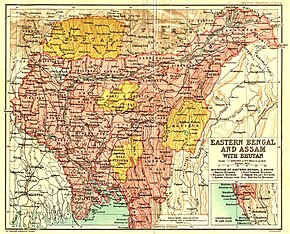History:Jaintia Kingdom
This article needs additional citations for verification. (July 2018) (Learn how and when to remove this template message) |
Jaintia Kingdom | |||||||
|---|---|---|---|---|---|---|---|
| 1500–1835 | |||||||
 The Khasi and Jaintia Hills in the Bengal Gazetteer, 1907 | |||||||
| Capital | Jaintia Rajbari, Jaintiapur | ||||||
| Religion | Hinduism | ||||||
| Government | Monarchy | ||||||
• (1500–1516) | Prabhat Ray | ||||||
• (1832–1835) | Rajendra Singh | ||||||
| History | |||||||
• Established | 1500 | ||||||
• Disestablished | 1835 | ||||||
| |||||||
The Jaintia Kingdom was a kingdom in present-day Bangladesh and North-East India. It was annexed by the British East India Company in 1835.
Etymology
One theory says that the word "Jaintia" is derived the shrine of Jayanti Devi or Jainteswari, an incarnation of the Hindu goddess Durga. Another theory says that the name is derived via Pnar (the tribe of the rulers) from Sutnuga, a former settlement; the myth of Jayanti Devi was probably created after the Hinduisation of the Jaintia kingdom.[1]
The Pnars (also called Jaintia) and War, speak Mon-Khmer languages that are related to Khasi.
Extent
The Jaintia Kingdom extended from the east of the Shillong Plateau of present-day Meghalaya in north-east India , into the plains to the south, and north to the Barak River valley in Assam, India .
The capital, Jaintiapur, now ruined, was located on the plains at the foot of the Jaintia Hills; it appears there may have been a summer capital at Nartiang in the Jaintia Hills, but little remains of it now apart from a Durga temple and a nearby site with many megalithic structures.
Much of what is today the Sylhet region of Bangladesh was at one time under the jurisdiction of the Jaintia king.
History
The origin of the Jaintia kingdom is unknown, but the Jaintia people share a megalithic culture with the related Khasi people on the Shillong plateau which is of uncertain age, but their common oral history claims that they settled the region in the distant past. After the 17th century invasion by the Kachari king Satrudaman, the Jaintia kingdom came under increasing Kachari and Ahom political influence.
British annexation
The British came into contact with the Jaintia kingdom upon receiving the Diwani of Bengal in 1765 (Gurdon 1914:xiv). Jaintiapur, currently in Bangladesh, was the capital. The kingdom extended from the hills into the plains north of the Barak river (Gait 1906:253). The quarries in their possession was the chief supplier of lime to the delta region of Bengal, but with the British, the contact was not very smooth, and they were attacked in 1774. Subsequently, the Jaintias were increasingly isolated from the plains via a system of forts as well as via a regulation of 1799 (Gurdon 1914:xiv-xv).
After the conclusion of the First Anglo-Burmese War, the British allowed the Jaintia king his rule north of the Surma river (Gait 1906:284).
The kingdom was finally annexed on 15 March 1835 (Gait 1906:302). The king was handed over his property in Sylhet along with a monthly salary of Rs 500. The British administered the plain areas directly and the hill region indirectly via a system of fifteen dolois and four sardars. The fifteen administrators were free to adjudicate on all but the most heinous crimes.
Rulers
- Prabhat Ray (1500–1516)
- Majha Gosain (1516–1532)
- Burha Parbat Ray (1532–1548)
- Bar Gosain (1548–1564)
- Bijay Manik (1564–1580)
- Pratap Ray (1580–1596)
- Dhan Manik (1596–1612)
- Jasa Manik (1612–1625)
- Sundar Ray (1625–1636)
- Chota Parbat Ray (1636–1647)
- Jasamanta Ray (1647–1660)
- Ban Singh (1660–1669)
- Pratap Singh (1669–1678)
- Lakshmi Narayan (1678–1694)
- Ram Singh I (1694–1708)
- Jay Narayan (1708–1731)
- Bar Gosain (1731–1770)
- Chattra Singh (1770–1780)
- Bijay Narayan (1780–1790)
- Ram Singh II (1790–1832)
- Rajendra Singh (1832–1835)
Notes
- ↑ Soumen Sen (2004). Khasi-Jaintia folklore: context, discourse, and history. NFSC. pp. 56. ISBN 978-81-901481-3-9. https://books.google.com/books?id=r6p0GXek13cC&pg=PA56. Retrieved 2 December 2011.
References
- Gait, Edward A (1906). A Historyof Assam. Calcutta. https://books.google.com/books?id=GvcRAAAAYAAJ.
- Gurdon, Philips Richards Thornhugh (1914). The Khasis. London: Macmillan & Co.. https://books.google.com/books?id=g3wkAAAAMAAJ.

